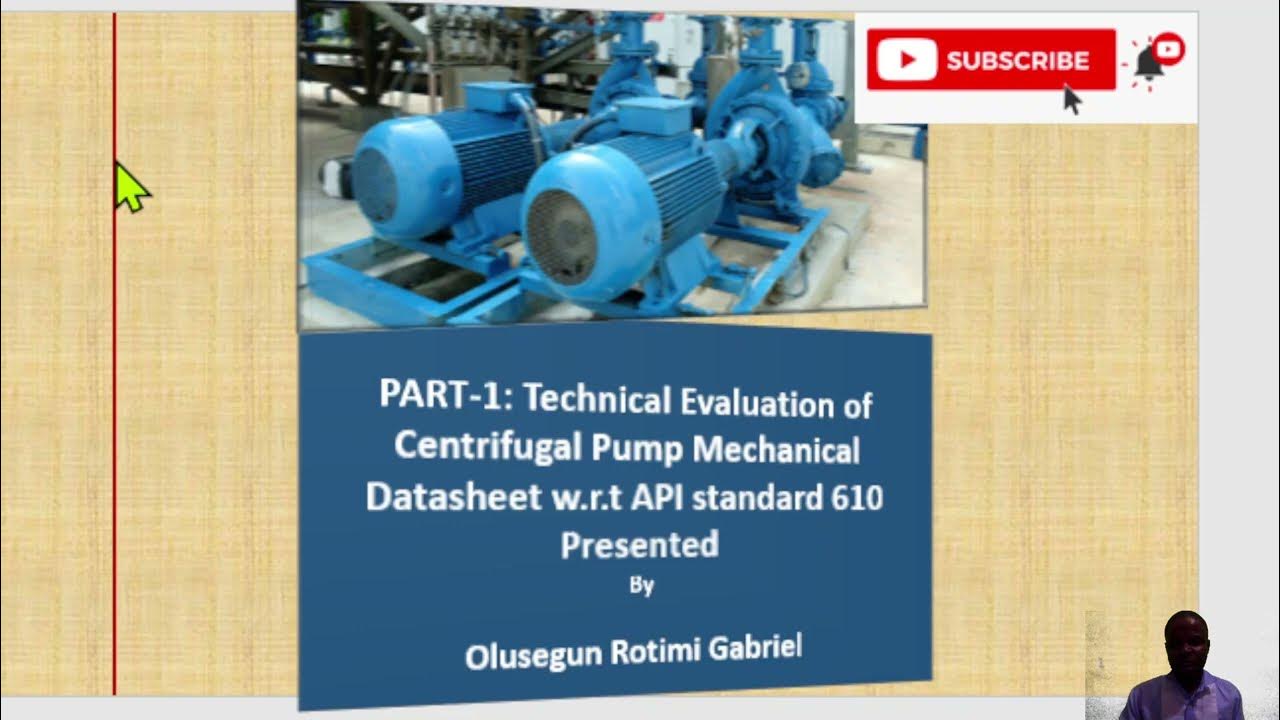Centrifugal Pump Basics - How centrifugal pumps work working principle hvacr
Summary
TLDRIn this video, Paul from The Engineering Mindset provides an in-depth look at centrifugal pumps, explaining their components and operation. He details how the motor converts electrical energy to mechanical energy, driving the pump to move liquids. The impeller's role in creating centrifugal force and the importance of maintaining net positive suction pressure (NPSH) to prevent cavitation are emphasized. Applications of centrifugal pumps in various systems, such as heating circuits and centralized cooling systems, are discussed. The video serves as a comprehensive introduction to understanding and utilizing centrifugal pumps effectively.
Takeaways
- 🔧 Centrifugal pumps convert electrical energy into mechanical energy using an induction motor to move liquids.
- 💧 The pump consists of two main parts: the motor and the pump itself, which includes an impeller and casing.
- ⚙️ The impeller generates centrifugal force, pulling liquid in through the suction inlet and pushing it out through the discharge outlet.
- 🌪️ Water flow is facilitated by the design of the pump casing, particularly the volute, which expands to increase pressure.
- 🔄 A rotating magnetic field is created within the motor, causing the rotor to spin, which in turn spins the impeller.
- 📉 NPSH (Net Positive Suction Head) is critical; it includes NPSHR (required) and NPSHA (available) to ensure proper pump operation.
- 🚨 Cavitation occurs when pressure drops below vapor pressure, leading to damage from collapsing air particles in the liquid.
- 🏠 Small centrifugal pumps can be used in domestic heating systems to circulate water efficiently.
- 🏢 Larger centrifugal pumps are employed in industrial settings, such as moving condenser water in cooling systems.
- 📚 Understanding the components and operation of centrifugal pumps is essential for effective installation and maintenance.
Q & A
What are the two main components of a centrifugal pump?
-The two main components of a centrifugal pump are the pump itself and the motor, which typically is an electrical induction motor.
How does the motor in a centrifugal pump operate?
-The motor converts electrical energy into mechanical energy, which is used to drive the pump and move the fluid, typically water.
What is the function of the impeller in a centrifugal pump?
-The impeller imparts centrifugal force to the fluid, enabling the movement of liquids through the pump and into the discharge outlet.
What is the role of the volute in a centrifugal pump?
-The volute is a spiraled channel in the pump casing that directs the flow of water and allows it to expand, which increases pressure and decreases velocity.
What does NPSH stand for, and why is it important?
-NPSH stands for Net Positive Suction Head. It is important because it determines the pressure conditions under which a pump operates to avoid cavitation.
What is cavitation, and what causes it?
-Cavitation occurs when the pressure of the fluid drops below its vapor pressure, causing bubbles to form and collapse, which can damage the pump.
How does the motor cooling fan contribute to the operation of a centrifugal pump?
-The cooling fan helps dissipate heat from the motor, preventing overheating that could lead to insulation failure and motor damage.
What is the difference between NPSHR and NPSHA?
-NPSHR is the required Net Positive Suction Head needed by the pump to operate without cavitation, while NPSHA is the available Net Positive Suction Head based on the installation conditions.
Can you provide examples of applications for centrifugal pumps?
-Centrifugal pumps are used in various applications, such as moving heated water in domestic heating systems and circulating condenser water in industrial cooling systems.
What types of impellers are commonly found in centrifugal pumps?
-Common types of impellers in centrifugal pumps include those with backward curved vanes, which can be open, semi-open, or closed with shrouds.
Outlines

このセクションは有料ユーザー限定です。 アクセスするには、アップグレードをお願いします。
今すぐアップグレードMindmap

このセクションは有料ユーザー限定です。 アクセスするには、アップグレードをお願いします。
今すぐアップグレードKeywords

このセクションは有料ユーザー限定です。 アクセスするには、アップグレードをお願いします。
今すぐアップグレードHighlights

このセクションは有料ユーザー限定です。 アクセスするには、アップグレードをお願いします。
今すぐアップグレードTranscripts

このセクションは有料ユーザー限定です。 アクセスするには、アップグレードをお願いします。
今すぐアップグレード関連動画をさらに表示

Types of pump | Working methods

Bombas Centrífugas - Tipos

Centrifugal Pump Basics I Definition I Working I Velocity Triangle I Work Done I Head I Efficiency

POMPA | Definisi Pompa | Jenis-jenis Pompa

Centrifugal Pump Hindi | Centrifugal Pump parts and Working

PART-1: Technical Evaluation of Centrifugal Pump Mechanical Datasheet with respect to API 610
5.0 / 5 (0 votes)
